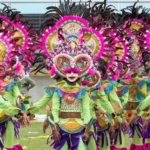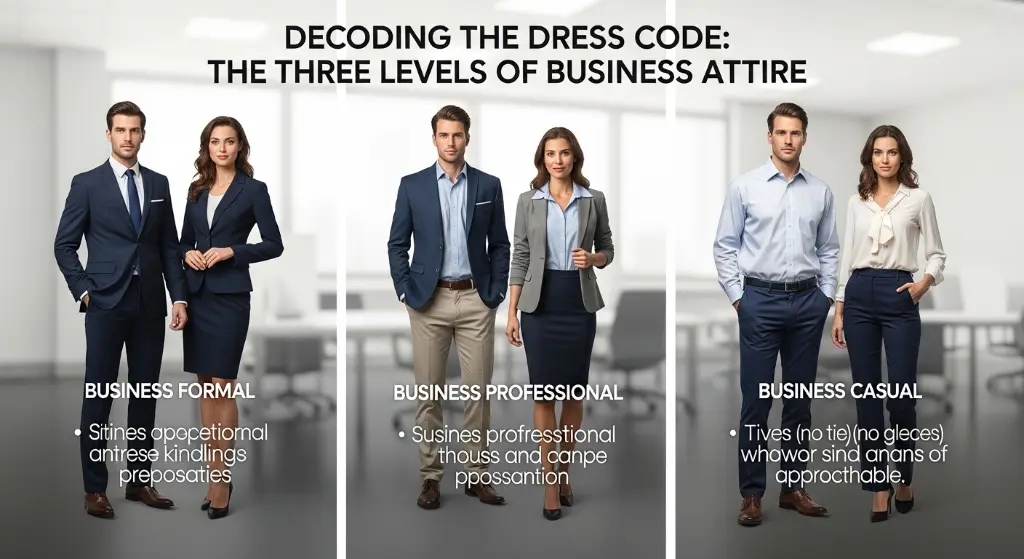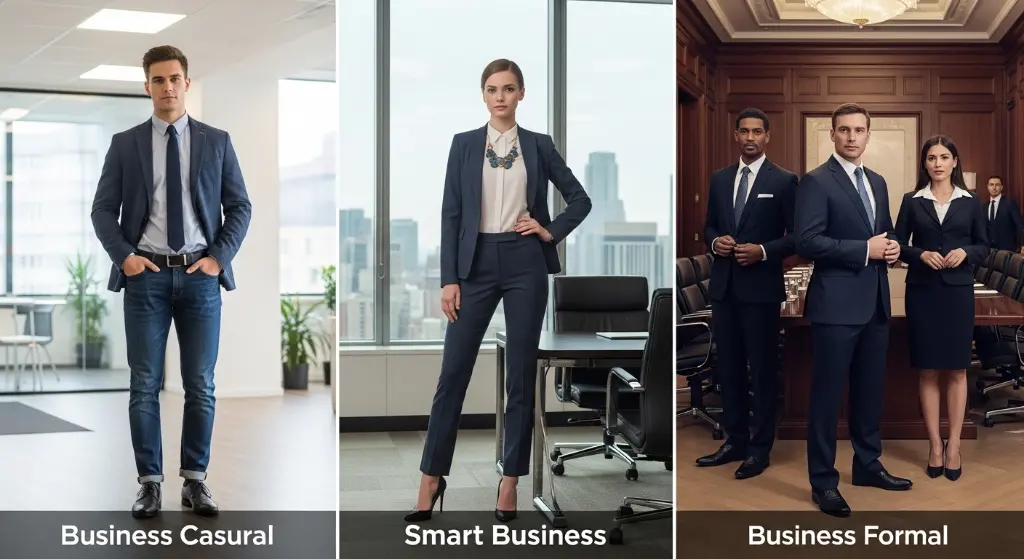Not sure what to wear to your next business meeting? This guide breaks down the dress code, from formal boardrooms to casual client lunches, with outfit examples and tips to ensure you always look professional and confident.
Professional Attire for Men
You’ve prepared your presentation. You know your numbers. You’re ready to close the deal. But then comes the question that can throw even the most confident professional off balance:
“What should I wear?”
In the world of business, your outfit is more than just clothing. It’s your personal brand. It’s the first impression you make before you even say a word. It communicates respect, competence, and attention to detail. Dressing appropriately for a meeting isn’t about being flashy; it’s about showing that you understand the context and that you take the occasion seriously.
See also Day of the Dead: A Vibrant Celebration of Life, Love, and Remembrance 🎊💀🌸
Day of the Dead: A Vibrant Celebration of Life, Love, and Remembrance 🎊💀🌸
The modern workplace has a confusing array of dress codes, from “business formal” to the ever-elusive “smart casual.” How do you navigate it?
In this ultimate guide, we will break down exactly what to wear for any business meeting. We’ll cover:
✅ The three main levels of business attire: Formal, Professional, and Casual.
✅ Go-to outfit formulas for each situation.
✅ The small details that make a huge difference (shoes, accessories, and grooming).
✅ Tips for dressing for video conference meetings.
✅ How to decode the dress code when you’re unsure.
Get ready to eliminate the guesswork and walk into your next meeting with unshakable confidence.
Decoding the Dress Code: The Three Levels of Business Attire
Before you choose your outfit, you need to understand the environment. Business meeting attire generally falls into three categories.
See also Comparing Traditional Festivals in Asian and European Cultures
Comparing Traditional Festivals in Asian and European Cultures

Level 1: Business Formal (The Boardroom Standard)
- When to wear it: High-stakes meetings with top-level executives, board meetings, meetings in conservative industries like finance, law, or government. This is for when you need to project maximum authority and professionalism.
- The goal: To look powerful, polished, and traditional.
Level 2: Business Professional / Business Casual (The Daily Standard)
- When to wear it: Most day-to-day office meetings, client lunches, presentations to middle management, or when meeting with a company whose culture is professional but not strictly formal. This is the most common dress code.
- The goal: To look sharp, competent, and approachable.
Level 3: Smart Casual / Business Casual (The Modern Standard)
- When to wear it: Meetings in creative or tech industries, casual Friday meetings, or a coffee meeting with a colleague or a relaxed client.
- The goal: To look stylish and put-together, but relaxed and modern.
The Golden Rule: If you are ever in doubt, it is always better to be slightly overdressed than underdressed. It shows you made an effort and respect the occasion.
🕴️ Level 1: Business Formal – The Power Suit
When the stakes are high, the suit is non-negotiable. This is about classic, timeless power dressing.
The Outfit Formula:
- The Suit: A well-fitting, two-piece suit is the foundation.
- Colors: Stick to conservative colors: charcoal grey or navy blue. Black suits are generally reserved for funerals or very formal evening events.
- Fabric: Wool is the best choice for its drape and year-round comfort.
- Fit: This is everything. The jacket should sit cleanly on your shoulders, and the trousers should have a clean break over your shoes. Invest in a good tailor.
- The Shirt: A crisp, long-sleeved dress shirt.
- Color: White is the most formal and safest choice. A light blue shirt is also acceptable.
- Fabric: 100% cotton. Make sure it is perfectly ironed.
- The Tie: A conservative silk tie.
- Pattern: A subtle pattern like a neat geometric print or a classic stripe is best. Avoid loud or novelty ties.
- Knot: A simple Four-in-Hand or a half-Windsor knot works well. The tip of the tie should just touch the top of your belt buckle.
- The Shoes: Leather dress shoes.
- Style: Oxfords are the most formal and best choice. Polished Derbys are also acceptable.
- Color: Black shoes with a navy or charcoal suit. Dark brown shoes can work with navy, but black is safer for the most formal settings.
- Socks: Dark dress socks that match the color of your trousers. No white athletic socks. Ever.
- The Belt: A simple leather belt that matches the color and finish of your shoes.
Business Formal Checklist:
- Dark, tailored suit (charcoal or navy).
- White or light blue dress shirt.
- Conservative silk tie.
- Polished black leather Oxfords.
- Matching leather belt.
- Dark dress socks.
👔 Level 2: Business Professional – The Blazer and Trousers
This is the most versatile category. It’s professional without the rigidity of a full suit. It’s about mixing and matching separates smartly.
The Outfit Formula:
- The Foundation: A blazer or sport coat paired with dress trousers (chinos or wool slacks).
- The Blazer: A navy blazer is the most essential item in a man’s professional wardrobe. Other good options are grey, brown, or a subtle check pattern.
- The Trousers: Choose a contrasting color. For example, a navy blazer with grey wool trousers or khaki chinos. Avoid wearing a blazer with trousers of a nearly-but-not-quite-matching color.
- The Shirt: A long-sleeved dress shirt.
- Colors: You can be more creative here. White and light blue are always safe, but you can also wear shirts with subtle patterns like a fine stripe or a small check.
- The Tie (Optional): A tie elevates the look, but it’s not always necessary in a business professional setting.
- When to wear it: If you’re meeting with clients or executives.
- When to skip it: For internal meetings or a more relaxed client lunch. If you skip the tie, leave the top button of your shirt undone.
- The Shoes: High-quality leather shoes.
- Style: You have more options here. Oxfords, Derbys, Loafers, or Monk Straps all work well.
- Color: Dark brown, tan, or oxblood shoes are excellent choices and more versatile than black in this context. Ensure they are clean and polished.
- The Belt: A leather belt that matches your shoes.
Business Professional Checklist:
- Blazer or sport coat (navy is a great start).
- Contrasting dress trousers or chinos.
- Patterned or solid-colored dress shirt.
- Tie (optional).
- Polished leather shoes (brown is very versatile).
- Matching belt.
👕 Level 3: Smart Casual – The Modern Professional
This is the trickiest dress code to get right. It’s about looking relaxed and stylish, but still professional. The key is to elevate casual pieces.
The Outfit Formula:
- The Top Layer (Optional but Recommended): A casual sport coat, a structured cardigan, a stylish bomber jacket, or even a clean, dark-wash denim jacket (in very creative fields).
- The Shirt:
- A high-quality button-down shirt (like an Oxford cloth button-down, or OCBD) is a perfect choice. You can roll up the sleeves for a more relaxed look.
- A premium, well-fitting polo shirt or even a plain, high-quality t-shirt (in a solid, neutral color) can work if layered under a blazer in a creative setting.
- The Trousers:
- Chinos are the king of smart casual. Colors like khaki, navy, olive, and grey are very versatile.
- Dark-wash, well-fitting jeans with no rips or fading can be acceptable, but only if you are certain the meeting environment is very relaxed (e.g., a tech startup). When in doubt, choose chinos.
- The Shoes: This is where you can show some personality.
- Clean, minimalist leather sneakers (in white or brown) are a modern and stylish choice.
- Loafers, desert boots, or chukka boots are also excellent options.
- Avoid athletic running shoes.
Smart Casual Checklist:
- Well-fitting chinos or dark-wash jeans.
- Button-down shirt or premium polo.
- Optional layering piece (blazer, cardigan).
- Clean leather sneakers or smart boots/loafers.

💻 The Zoom Meeting: Dressing for the “Waist Up”
Video meetings have their own rules. What matters is what’s visible on camera.
- Focus on the Top Half: Your shirt and any layering piece are most important. A dress shirt or a smart polo works well. A blazer instantly adds authority.
- Choose Solid Colors: Solid, medium colors like blue, grey, or burgundy look best on camera. Avoid busy patterns that can be distracting, and pure white or black, which can cause exposure issues for the camera.
- Pay Attention to Your Background: A clean, organized, and well-lit background is as important as your outfit.
- Don’t Forget the Bottom Half! Wear proper trousers or chinos. You never know if you’ll have to stand up unexpectedly. Avoid the “news anchor” look (business on top, pajama pants on the bottom).
Conclusion: Confidence is the Best Outfit
Dressing for a business meeting isn’t about following rigid rules; it’s about showing respect for the people you’re meeting and the situation you’re in.
Your Quick-Reference Cheat Sheet:
- High-Stakes Boardroom? Go Business Formal. A dark suit is your armor.
- Standard Client Meeting? Go Business Professional. A navy blazer is your best friend.
- Creative Tech Startup? Go Smart Casual. Chinos and a button-down are your go-to.
- In Doubt? Dress up, not down. It’s always better to be the best-dressed person in the room.
Ultimately, the best outfit is one that is clean, well-fitting, and makes you feel confident. When you feel good about how you look, you can stop worrying about your clothes and focus on what really matters: acing that meeting.


